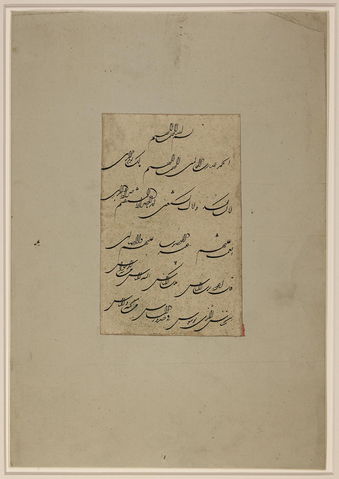 |
This is a file from the Wikimedia Commons. Information from its description page there is shown below.
Commons is a freely licensed media file repository. You can help.
|
| DescriptionShikastah script.jpg |
English: This calligraphic fragment is executed in fine shikastah (literally, "broken") script and includes an initial bismillah and chapters (surahs) 1 and 114 of the Qur'an. At the top appears the first chapter of the Qur'an, entitled al-Fatihah (The Opening).
These two short surahs from the Qur'an appear together here probably because they are short, easily memorized, and recited aloud. It is quite unusual, however, to find Qur'anic verses executed in shikastah, a very fluid script invented in Persia (Iran) by the 18th-century calligrapher Darvish 'Abd al-Majid al-Taliqani (Tavoosi 1987: 34-35). During the 18th and 19th centuries, Qur'ans were written in naskh or nasta'liq, as these scripts were more legible than shikastah. For this reason, this particular fragment stands out as scarce proof that some Qur'anic ayahs were executed in shikastah in Iran during the 18th-19th centuries.
|
| Date |
18th-19th centuries |
| Source |
 |
This calligraphic fragment is available from the United States Library of Congress's African & Middle Eastern division under the digital ID ascs.102.
This tag does not indicate the copyright status of the attached work. A normal copyright tag is still required. See Commons:Licensing for more information.
|
|
| Author |
Unknown calligrapher |
Permission
( Reusing this file) |
This is a faithful photographic reproduction of an original two-dimensional work of art. The work of art itself is in the public domain for the following reason:
| Public domainPublic domainfalsefalse |
 |
This image (or other media file) is in the public domain because its copyright has expired.
This applies to Australia, the European Union and those countries with a copyright term of life of the author plus 70 years.
 You must also include a United States public domain tag to indicate why this work is in the public domain in the United States. Note that a few countries have copyright terms longer than 70 years: Mexico has 100 years, Colombia has 80 years, and Guatemala and Samoa have 75 years, Russia has 74 years for some authors. This image may not be in the public domain in these countries, which moreover do not implement the rule of the shorter term. Côte d'Ivoire has a general copyright term of 99 years and Honduras has 75 years, but they do implement the rule of the shorter term. You must also include a United States public domain tag to indicate why this work is in the public domain in the United States. Note that a few countries have copyright terms longer than 70 years: Mexico has 100 years, Colombia has 80 years, and Guatemala and Samoa have 75 years, Russia has 74 years for some authors. This image may not be in the public domain in these countries, which moreover do not implement the rule of the shorter term. Côte d'Ivoire has a general copyright term of 99 years and Honduras has 75 years, but they do implement the rule of the shorter term.
|
|
This file has been identified as being free of known restrictions under copyright law, including all related and neighboring rights.
|
The official position taken by the Wikimedia Foundation is that "faithful reproductions of two-dimensional public domain works of art are public domain, and that claims to the contrary represent an assault on the very concept of a public domain". For details, see Commons:When to use the PD-Art tag.
This photographic reproduction is therefore also considered to be in the public domain. Please be aware that depending on local laws, re-use of this content may be prohibited or restricted in your jurisdiction. See Commons:Reuse of PD-Art photographs.
{{ PD-Art}} template without parameter: please specify why the underlying work is public domain in both the source country and the United States
(Usage: {{PD-Art|1=|deathyear=|country=|date=}}, where parameter #1 can be PD-old-auto, PD-old-auto-1923, PD-old-100 or similar)
|
|
File usage
The following pages on Schools Wikipedia link to this image (list may be incomplete):
Through Schools Wikipedia, SOS Childrens Villages has brought learning to children around the world. Thanks to SOS Children, 62,000 children are enjoying a happy childhood, with a healthy, prosperous future ahead of them. Have you thought about sponsoring a child?




